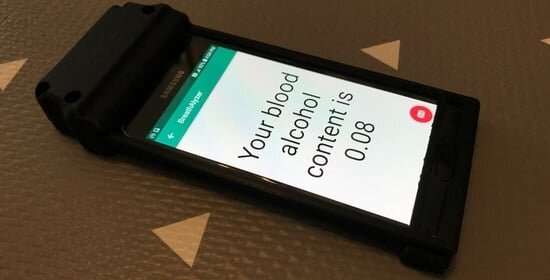Researchers develop smartphone-screen-integrated optical breathalyzer

Alcohol abuse is a global concern. Every year in the United States alone, thousands of drivers die from drunk driving. These tragic incidents could be greatly reduced if the public had access to a breathalyzer at anytime and anywhere. Unfortunately, the public is simply not interested in carrying such an object.
Researchers from the Centre for Optics, Photonics and Lasers (COPL) at Laval University, Canada, have analyzed this widespread issue and found a potential solution: embedding a breathalyzer in a smartphone. Of course, this idea is not new; several scientific communities have attempted this feat. The problem is that current technologies for detecting blood alcohol levels are not adequate to be integrated into phones. Indeed, they are bulky, expensive, complex to mass produce and not durable due to the need for chemical sensor replacements.
Instead of trying to integrate an existing breathalyzer technology into the phone, the researchers wondered if existing components in phones could be used to measure blood alcohol content. This question led them to an interesting invention: an optical breathalyzer integrated to the phone's screen. The operating principle is based on the evaporation of the breath fog on the screen. When a window is fogged, thousands of microdroplets form on the surface. When breath contains alcohol, these microdroplets evaporate faster because alcohol evaporates faster than the water contained in the breath of a sober person.
Researchers had to be ingenious to find a way to measure this evaporation rate. Multimedia glass screens, such as Gorilla glass, used to protect phones, tablets and smartwatches, have an anti-scratch layer. This layer is denser than the rest of the glass and forms a planar waveguide. As found in an optical fiber with a core that is denser than the surrounding area, light can be guided from one end of the piece to the other. The source of light used in the new technology is simply that of the phone's display. This light normally passes through the glass screen without being deflected to reach our eyes. However, when the screen is fogged, some of the light is coupled to the planar waveguide on the surface of the screen and guided to the side of the screen where a photodiode is placed to measure the light intensity.
The coupling to the planar waveguide takes place due to a strong total internal reflection that occurs at the edge of each microdroplet. The light intensity measured at the photodiode is therefore proportional to the number of microdroplets and decreases with evaporation. When the fog contains alcohol, the microdroplets on the screen evaporates at a faster rate, and the intensity measured at the photodiode also decreases faster. The researchers demonstrated a correlation between the light intensity signature and the user's blood alcohol level.
The researchers built a prototype powered by the phone's battery with an app to guide the user on how to take the blood alcohol test. Only one component needs to be added into the phone: a photodiode. Obviously, a photodiode is affordable and modern phones already have several integrated (e.g., proximity sensor, ambient light sensor). The prototype has been tested at several parties to understand the parameters and conditions that could affect the measurements.
"We are very excited about this new technology that could make a real impact in society," says Dr. Jerome Lapointe, first author of the article published in Sensors. "While the technology works well in a controlled environment, the ambient conditions in a real-world environment greatly affect the measurements. For example, if it is warmer or less humid, the fog on the screen evaporates at a faster rate. Therefore, it will be necessary to test in all possible conditions so that the breathalyzer can be calibrated. Fortunately, today's phones have several sensors, including temperature and humidity ones, that can be used to record all conditions for each test. After accumulating a large database, we hope to use artificial intelligence by training a neural network to obtain accuracy that will convince major phone manufacturers to integrate the breathalyzer into screens."
More information: Jerome Lapointe et al, Smartphone Screen Integrated Optical Breathalyzer, Sensors (2021). DOI: 10.3390/s21124076




















